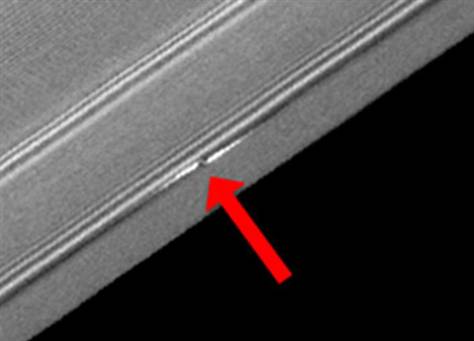Astronomers have been able to use the Saturn-orbiting Cassini spacecraft to track what are believed to be half-mile wide moons embedded in the planet's outermost dense ring, known as the A ring. The moonlets were found by perturbations they are creating in the structure of the ring, which is about 30 feet thick. The moonlets' gravitational grip is causing 1,600-foot long shoots of material above and below ring, reports Matthew Tiscareno, a Cassini scientist at Cornell University, in this week's issue of Astrophysical Journal Letters.
Scientists estimate there are dozens of these extremely long propeller-like features toward the outer edge of Saturn's A ring and have been tracking 11 of them for four years -- the first time a disk-embedded object has ever been tracked anywhere.
"All the moons and planets we knew about before orbit in empty space. With this new discovery, we can now track disk-embedded moons individually over many years," Tiscareno said in the press release.
Similar, smaller propeller features were first found in 2006 in the middle of the A ring, an area now known as the "propeller belts." Those features, however, couldn't be traced to individual objects.

Watching how the moonlets' orbits change and evolve over time should give scientists greater insight into the formation of planetary systems, which evolve from similar, though much larger, debris disks.
"It allows us a glimpse into how the solar system ended up looking the way it does," said Cassini imaging team head Carolyn Porco, with the Space Science Institute in Boulder, Colorado.
Watch Video: NASA and ESA astronomers released movies of Saturn's northern and southern lights, glimpsed edge-on for the first time by the Hubble Space Telescope.




Maybe these newly discovered moons aren't moons at all. Maybe they are the same type objects (planet size) that can be seen in the suns corona. See links below for examples.
[Link]
[Link]